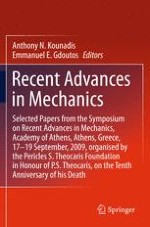This book contains 24 papers presented at the symposium on “Recent Advances in Mechanics” dedicated to the late Professor – Academician Pericles S. Theocaris in commemoration of the tenth anniversary of his death. The papers are written by world renowned and recognized experts in their fields and serve as a reference and guide for future research.
The topics covered in the book can be divided into three major themes: Mathematical methods in applied mechanics (nine papers), experimental mechanics (nine papers) and fracture mechanics (six papers).
Topics covered include: Application of reciprocity relations to laser-based ultrasonics, boundary value problems of the theory of elasticity, optimal design in contact mechanics, scaling of strength and lifetime distributions of quasibrittle structures, directional distortional hardening in plasticity, vibration of systems, instability phenomena in damped systems, variational methods for static and dynamic elasticity problems, an accelerated Newmark scheme for solving the equations of motion in the time domain, photoelastic tomography, electronic speckle pattern interferometry, composites exposed to fire, sampling moiré, microelecromechanical systems, experimental mechanics in nano-scale, advanced cement based nanocomposites, piezonuclear transmutations in brittle rocks under mechanical loading, stress triaxiality at crack tips studied by caustics, reinforcement of a cracked elastic plate with defects, some actual problems of fracture mechanics, cyclic plasticity with applications to extremely low cycle fatigue of structural steel, and fracture of a highly filled polymer composite.
